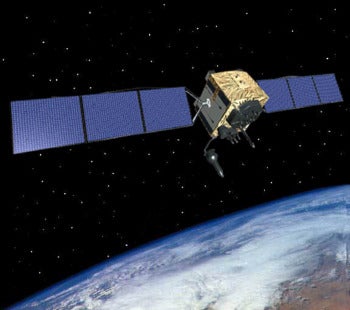Testing is about to begin on the next-generation of Global Positioning System satellites, with the arrival of a prototype unit at a Lockheed Martin complex in Colorado.
Block III GPS Satellites will be able to determine position to within three feet, compared to 10 feet with current technology, the Associated Press reports. That translates to more accurate directions while driving, and more importantly, better tracking when the user is on foot. More accurate navigation will prove especially valuable as tech companies such as Google try to take their mapping apps indoors to shopping malls and transit hubs,
These "Block III" satellites are part of a $5.5 billion upgrade to GPS, a government-run system that consumers rely on for directions on their phones, cars and standalone navigation devices. What does the big upgrade mean for consumers? Here are the big improvements that Block III aims to provide:
Better Accuracy
Block III GPS Satellites will be able to determine position to within three feet, compared to 10 feet with current technology, the Associated Press reports. That translates to more accurate directions while driving, and more importantly, better tracking when the user is on foot. More accurate navigation will prove especially valuable as tech companies such as Google try to take their mapping apps indoors to shopping malls and transit hubs,
 More Reliable Coverage
More Reliable Coverage
Block III GPS is supposed to be more reliable in areas where the current technology is shaky, such as under heavy tree canopies or on city streets surrounded by skyscrapers. And as Google Maps project manager Steve Lee told Wired last month, GPS doesn't work well indoors, so Google had to do a lot of extra work to improve accuracy. The more powerful Block III satellites should be more reliable in covered areas and may reduce the amount of work needed for indoor applications.
Safer from Jamming
The AP notes that Block III's higher-powered signal will be "harder for enemies to jam," but intentional attacks may not be the only concern. Consumer-grade GPS jammers, which are illegal to sell or use but are nonetheless popular among commercial drivers who don't want to be tracked by their employers, also pose a safety risk. In 2009, for instance, one trucker's signal jammer was interfering with GPS at Newark airport in New Jersey. Block III's more powerful transmissions will improve resistance to GPS jamming.
The prototype that arrived at Lockheed Martin this week won't be launched into space. The first flight model will arrive next summer, with the goal of launching in May 2014. Ultimately the Pentagon wants to buy 32 satellites with the new technology, but we'll be using the existing technology for at least the next couple of years.
Source http://www.pcworld.com






0 comments:
Post a Comment